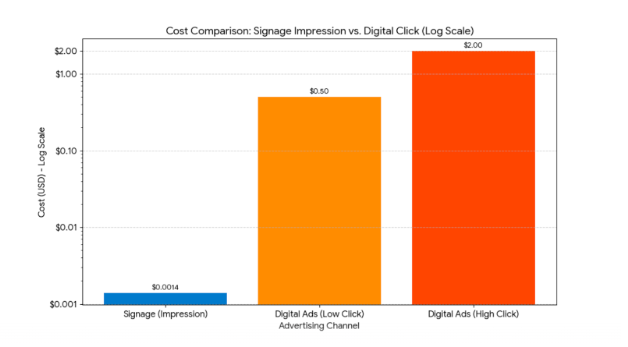News
How Signs Boost Your Business Net Worth

Your business signage does more than display your company name. Strategic signage directly affects your bottom line, customer behavior, and long-term financial health.
Understanding this connection helps you make informed decisions about your visual marketing investments.
The Financial Impact of Business Signage
Research from FedEx Newsroom reveals that nearly 76% of consumers enter a store they have never visited based on its signs alone. This statistic translates to real revenue opportunities. When potential customers walk past your location, your signage serves as a silent salesperson working 24 hours a day.
The Sign Research Foundation found that on-premises signs are the most cost-effective form of advertising for businesses. A well-designed sign costs pennies per impression compared to traditional advertising channels.
For businesses in competitive markets, including those working with professional sign installation Colorado Springs CO services, this efficiency becomes even more critical when establishing market presence.
Investing in signage delivers a measurable return. Studies show that businesses typically see an average sales increase of 10% after installing or upgrading their signage. For example, a business with $500,000 in annual revenue could generate an additional $50,000 from this one-time investment.
Customer Perception and Brand Value
First impressions shape customer expectations before they interact with your staff. Your exterior signage creates immediate assumptions about your business quality, professionalism, and reliability.
A University of Cincinnati study found that consumers make subconscious judgments about businesses within 10 seconds of seeing their signage. Poor signage leads to assumptions about poor service or product quality. High-quality signage elevates perceived value, allowing you to command premium pricing.
Visibility Creates Market Share
Location matters, but visibility matters more. A prime location with poor signage loses to an average location with excellent signage. Your signs create awareness in your immediate market, building familiarity that converts to customer preference.
The Small Business Administration reports that signage accounts for the difference between success and failure for many retail operations. Customers choose familiar brands, and your signage builds this familiarity through repeated exposure.
Multiple Sign Types Serve Different Functions
Exterior monument signs establish permanent presence and brand identity. These ground-level structures create professional impressions and help customers find your location.
Window graphics transform unused glass into advertising space while maintaining interior visibility. These graphics cost less than traditional signage while delivering consistent messaging.
Interior signage guides customer behavior, promotes products, and reinforces brand identity. Strategic placement influences purchase decisions and increases transaction values.
Digital displays offer flexibility to change messages based on time, weather, or inventory. These dynamic signs capture attention more effectively than static alternatives.
Directional signage reduces customer frustration and improves experiences. When customers find what they need quickly, they spend more time shopping and less time searching.
Quantifying Signage Return on Investment
Calculate your signage ROI by tracking several metrics. Customer counts before and after installation show immediate impact. Ask new customers how they found you, and track responses mentioning your signage.
Compare your cost per impression against other advertising channels. A $5,000 sign lasting 10 years with 1,000 daily views costs approximately $0.0014 per impression. Compare this to digital advertising at $0.50 to $2.00 per click.

The data highlights that the cost per impression for the example sign ($0.0014) is hundreds to over a thousand times cheaper than the lower end of the digital ad cost per click ($0.50 to $2.00), underscoring the strong long-term return on investment (ROI) of physical signage.
Monitor sales patterns after signage upgrades. Many businesses see immediate increases in foot traffic and sales volume. Document these changes to justify future investments.
Compliance and Professional Installation
Local regulations govern signage size, placement, lighting, and materials. Non-compliant signs result in fines, removal orders, and wasted investment. Professional installers understand these requirements and ensure compliance.
Poor installation creates safety hazards and liability exposure. Signs must withstand wind loads, weather exposure, and time. Professional installation includes proper permitting, structural analysis, and quality materials.
Signage as a Tangible Asset
Your business signage appears on balance sheets as a fixed asset. This classification affects your business valuation during sales, mergers, or loan applications. Quality signage adds measurable value to your business worth.
Banks and investors consider signage when evaluating business health. Established, professional signage indicates stability and market presence. This perception influences lending decisions and investment opportunities.
Strategic Placement Maximizes Impact
Traffic patterns determine optimal sign placement. Analyze vehicle and pedestrian flow to position signs where they receive maximum exposure. Consider sight lines, speed limits, and approach angles.
Multiple signs work together to create cumulative effects. A monument sign attracts initial attention, while window graphics reinforce messaging. Interior signs complete the journey by guiding purchases.
Corner locations benefit from dual-facing signs. High-traffic intersections offer premium exposure but require investment in larger, more visible signage.
Material Selection Affects Longevity and Cost
Aluminum signs resist weather damage and maintain appearance longer than cheaper alternatives. Initial costs run higher, but longevity reduces lifetime expenses.
Acrylic offers versatility for illuminated signs and maintains clarity better than polycarbonate. LED lighting reduces energy costs while improving visibility.
Vinyl graphics provide affordable temporary solutions but require replacement every three to five years. Budget for periodic updates when choosing this option.
Lighting Extends Operating Hours
Illuminated signage works while you sleep. Businesses with lit signs report higher evening and early morning traffic. This extended visibility increases your effective advertising hours from 12 to 24 per day.
LED technology reduces energy costs by 75% compared to traditional lighting. The initial investment pays back through lower utility bills and reduced maintenance.
Halo lighting creates sophisticated presentations while meeting code requirements. This approach highlights your brand without harsh glare.
Maintenance Protects Your Investment
Regular cleaning maintains professional appearance. Dirt, bird droppings, and weather residue diminish impact and shorten sign life. Schedule quarterly cleaning for exterior signs.
Inspect electrical components annually. Replace failing bulbs immediately to avoid dark spots that damage your brand image.
Faded signs send negative messages about your business. Plan for replacement or refurbishment every seven to ten years depending on materials and exposure.
Digital Integration Enhances Traditional Signage
QR codes on physical signs bridge offline and online experiences. Customers scan codes to access menus, promotions, or product information. This integration provides measurable engagement data.
Social media handles displayed on signage drive online following. Your physical presence supports digital growth, creating multiple touchpoints with customers.
Competitive Advantage Through Superior Signage
Your competitors use signage, making quality the differentiator. Superior signs capture market share from businesses with dated or poor signage. This advantage compounds over time as your brand becomes the recognized choice.
In markets with multiple similar businesses, signage often determines which business customers choose. The decision happens before they research products or compare prices.
Long-Term Value Creation
Business signage contributes to enterprise value in several ways. Brand recognition built through consistent signage creates customer loyalty worth multiples of revenue. When you sell your business, this recognition transfers to new owners.
Established signage reduces marketing costs for growth. New locations benefit from brand recognition built at existing sites. This efficiency improves margins and accelerates expansion.
Your signage tells your business story to thousands of potential customers. Each impression builds awareness, shapes perception, and drives purchasing decisions. These effects accumulate over months and years, creating lasting value for your business.
Professional signage represents strategic investment rather than expense. The right signs at the right locations generate returns far exceeding their costs while building equity in your brand and business worth.
-

 Rappers9 months ago
Rappers9 months agoGloRilla Net Worth: Height, Age, Bio, Real Name & Career
-

 Businessman9 months ago
Businessman9 months agoBrandon Fugal Net Worth: How Rich is Skinwalker Ranch Owner?
-

 Rappers3 years ago
Rappers3 years agoBigXthaPlug Net Worth: Height, Age, Real Name & Career
-

 TV Stars9 months ago
TV Stars9 months agoKaleb Cooper Net Worth: How Rich is the TV Star Actually?
-

 Internet Stars3 years ago
Internet Stars3 years agoMufti Menk Net Worth: How Rich is the Islamic Speaker Actually?
-

 TV Stars9 months ago
TV Stars9 months agoCarla Diab Net Worth: How Rich is the TV Star Actually in 2025?
-

 Businessman2 years ago
Businessman2 years ago7 Proven Lead Generation Strategies To Implement in 2023
-

 Rappers9 months ago
Rappers9 months agoDD Osama Net Worth: Height, Age, Real Name, Career & More



















You must be logged in to post a comment Login